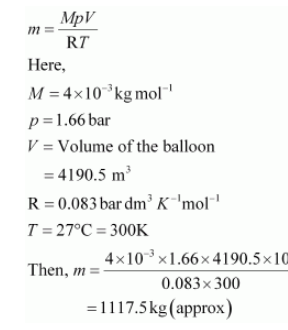Pay load is defined as the difference between the mass of displaced air and the mass of the balloon.
Pay load is defined as the difference between the mass of displaced air and the mass of the balloon. Calculate the pay load when a balloon of radius $10 \mathrm{~m}$, mass $100 \mathrm{~kg}$ is filled with helium at $1.66$ bar at $27^{\circ} \mathrm{C}$. (Density of air $=1.2 \mathrm{~kg} \mathrm{~m}^{-3}$ and $\mathrm{R}=0.083$ bar $\mathrm{dm}^{3} \mathrm{~K}^{-1} \mathrm{~mol}^{-1}$ ).
Given,
Radius of the balloon, r = 10 m
$\therefore$ Volume of the balloon $=\frac{4}{3} \pi r^{3}$
$=\frac{4}{3} \times \frac{22}{7} \times 10^{3}$
$=4190.5 \mathrm{~m}^{3}($ approx $)$
Thus, the volume of the displaced air is $4190.5 \mathrm{~m}^{3}$.
Given,
Density of air = 1.2 kg m–3
Then, mass of displaced air = 4190.5 × 1.2 kg
= 5028.6 kg
Now, mass of helium (m) inside the balloon is given by,

Now, total mass of the balloon filled with helium = (100 + 1117.5) kg
= 1217.5 kg
Hence, pay load = (5028.6 – 1217.5) kg
= 3811.1 kg
Hence, the pay load of the balloon is 3811.1 kg.
Click here to get exam-ready with eSaral
For making your preparation journey smoother of JEE, NEET and Class 8 to 10, grab our app now.
